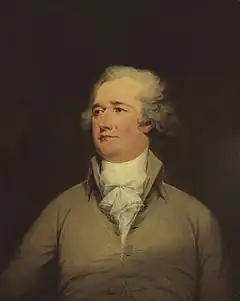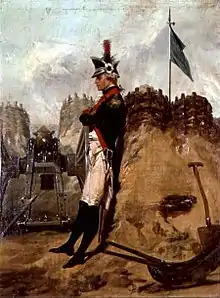 Alexander Hamilton, author of Federalist No. 25 | |
| Author | Alexander Hamilton |
|---|---|
| Original title | The Same Subject Continued: The Powers Necessary to the Common Defense Further Considered |
| Country | United States |
| Language | English |
| Series | The Federalist |
| Publisher | New York Packet |
Publication date | December 21, 1787 |
| Media type | Newspaper |
| Preceded by | Federalist No. 24 |
| Followed by | Federalist No. 26 |
Federalist No. 25 is an essay by Alexander Hamilton, the twenty-fifth of The Federalist Papers.[1] It was first published in The New York Packet on December 21, 1787, under the pseudonym Publius, the name under which all The Federalist papers were published.[1] It continues the discussion begun in Federalist No. 24.[2] No. 25 is titled "The Same Subject Continued: The Powers Necessary to the Common Defense Further Considered".[3]
Summary
Still considering the criticism of maintaining the national forces from Federalist No. 24, Publius now turns to the criticism that the States should provide for the national forces, rather than the Union as has been proposed.[4] Publius states that this would undermine the purpose of creating a Union, because it would rely on the individual members to support the Union's common defense.[5] He claims that this would be "oppressive to some States, dangerous to all, and baneful to the Confederacy."[6]
In explaining the danger, Publius demonstrates that the territories of foreign nations surround the entirety of the Union, making the danger common to all the States.[6] If one state in particular (Publius uses New York as an example) was attacked, it would be forced to provide all of its defense with no guarantee of support from other States.[6] Publius explains that the States themselves are too prone to power and ambition for any of them to reasonably rely on the provision of defense in a time of crisis.[7]
Later in the essay, Publius shifts back to the general importance of a Union-created military that would remain standing even during times of peace.[8] He explains that if the national forces could only be summoned during times of war, the Union would leave itself vulnerable to an initial strike.[9] Without a standing military, the Union would have to "receive the blow before we could even prepare to return it."[10] Such a system would not be functional if the Union is unable to prepare in advance of military strikes by foreign powers.[11]
Background and publication
Federalist No. 25 was written by Alexander Hamilton. Like all of the Federalist Papers, it was published under the pseudonym Publius in New York newspapers to explain the provisions of the Constitution of the United States and persuade New York to ratify it.[12] It was first published in the Daily Advertiser, the New-York Packet and the New-York Journal on December 21, 1787. It was then published in the Independent Journal on December 22.[13]
Federalist No. 25 continued the argument of Federalist No. 24 in favor of a standing army.[14] This had been an issue when forming the national government under the Articles of Confederation, when it was a point of contention during the 1783 committee of which Hamilton was a member. Here Hamilton had proposed a compromise of a small army totaling about 3,000 soldiers, supplemented by a part-time reserve force.[15]: 102
Analysis

Hamilton argued in Federalist No. 25 that oversight of the army should be the responsibility of the national government, not the state governments. Warning that states in a federal system are always at risk of rivalry, he speculated that allowing states their own armies would tempt states to engage in conflict with one another or with the national government.[16] As with Federalist No. 24, Hamilton maintained that a standing army is preferential to a militia, as those responsible for defense should be well-practiced.[14] His belief on the matter was influenced by the Revolutionary War, which he felt was not well-fought by the American militias. He felt that the nation could not be respected, either by its people or by foreign nations, without a strong means of defense.[17]
Hamilton warned that the United States was in a particularly vulnerable position because of its geography and that being "naked and defenseless" would invite hostility.[15]: 97 He insisted on creating a standing army preemptively, rather than waiting until hostilities had already begun.[17] Hamilton dismissed arguments that a standing army would enable tyranny by invoking the separation of powers that limited the executive's control over military affairs.[17][18] He also warned that putting individual states in charge of their own armies would cause disorganization.[16]
Hamilton believed that a national army would invite more scrutiny than state armies, allowing for greater accountability. Knowing that citizens were more closely aligned with their state governments than the national government, Hamilton believed that the people were in the most danger "when the means of injuring their rights are in the possession of those of whom they entertain the least suspicion". This was a dilemma for supporters of ratification: they believed that skepticism of the people would be a check on the national government, but they also needed the support of the people to create such a government.[18]
Hamilton also used Federalist No. 25 to explain that a constitution must not rule "counter to the necessities of society", as such provisions would likely be ignored by politicians when necessary. In Federalist No. 25, he speculated that even if disallowed by the constitution, a standing army would be raised any time a thread was perceived. He further suggested that violations of the constitution, even in urgent situations, would set precedent in favor of ignoring the constitution in other circumstances.[16][19]
Aftermath
Hamilton later revisited his argument that the constitution must not put undue restrictions on the government that will be ignored, discussing it in Federalist No. 40, No. 41, and No. 48.[17] Federalist No. 25 has been cited in cases before the Supreme Court of the United States: Lewis F. Powell Jr. cited it in Selective Service System v. Minnesota Public Interest Research Group (1984) and Wayte v. United States (1985), and John Paul Stevens cited it in Perpich v. Department of Defense (1990).[20]
References
- 1 2 Hamilton, Alexander. "Federalist No. 25". The Federalist Papers. Library of Congress. Archived from the original on May 7, 2009. Retrieved December 7, 2011.
- ↑ The Federalist Papers. New York: New American Library, a division of Penguin Books. 1999. pp. 153–163. ISBN 0-451-52881-6.
- ↑ Hamilton, Alexander. "Federalist No. 25". The Avalon Project. Lillian Goldman Law Library, Yale University. Retrieved December 7, 2011.
- ↑ The Federalist Papers. New York: New American Library, a division of Penguin Books. 1999. p. 158. ISBN 0-451-52881-6.
- ↑ The Federalist Papers. New York: New American Library, a division of Penguin Books. 1999. pp. 158–159. ISBN 0-451-52881-6.
- 1 2 3 The Federalist Papers. New York: New American Library, a division of Penguin Books. 1999. p. 159. ISBN 0-451-52881-6.
- ↑ The Federalist Papers. New York: New American Library, a division of Penguin Books. 1999. pp. 159–160. ISBN 0-451-52881-6.
- ↑ The Federalist Papers. New York: New American Library, a division of Penguin Books. 1999. p. 160. ISBN 0-451-52881-6.
- ↑ The Federalist Papers. New York: New American Library, a division of Penguin Books. 1999. pp. 160–161. ISBN 0-451-52881-6.
- ↑ The Federalist Papers. New York: New American Library, a division of Penguin Books. 1999. p. 161. ISBN 0-451-52881-6.
- ↑ The Federalist Papers. New York: New American Library, a division of Penguin Books. 1999. p. 162. ISBN 0-451-52881-6.
- ↑ "Federalist Papers: Primary Documents in American History". Library of Congress. Archived from the original on July 17, 2023. Retrieved August 23, 2023.
- ↑ "Federalist Essays in Historic Newspapers". Library of Congress. Archived from the original on January 21, 2023. Retrieved August 23, 2023.
- 1 2 Scott, Kyle (2013). The Federalist Papers: A Reader's Guide. A&C Black. p. 93. ISBN 978-1-4411-0814-2.
- 1 2 Edling, Max M. (2020). "'A Vigorous National Government': Hamilton on Security, War, and Revenue". In Rakove, Jack N.; Sheehan, Colleen A. (eds.). The Cambridge Companion to the Federalist Papers. Cambridge University Press. ISBN 978-1-107-13639-7.
- 1 2 3 Millican, Edward (2014). One United People: The Federalist Papers and the National Idea. University Press of Kentucky. p. 97. ISBN 978-0-8131-6137-2.
- 1 2 3 4 Levinson, Sanford (November 24, 2015). An Argument Open to All: Reading "The Federalist" in the 21st Century. Yale University Press. pp. 91–93. ISBN 978-0-300-21645-5.
- 1 2 Epstein, David F. (2007). The Political Theory of The Federalist. University of Chicago Press. pp. 48–49. ISBN 978-0-226-21301-9.
- ↑ Potter, Kathleen O. (2002). The Federalist's Vision of Popular Sovereignty in the New American Republic. LFB Scholarly Pub. p. 96. ISBN 978-1-931202-44-2.
- ↑ Durchslag, Melvyn R. (2005). "The Supreme Court and the Federalist Papers: Is There Less Here Than Meets the Eye?". William & Mary Bill of Rights Journal. 14 (1): 336–337, 342.